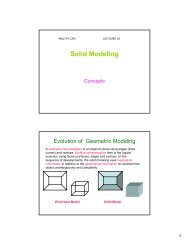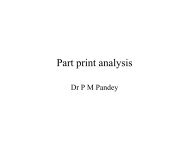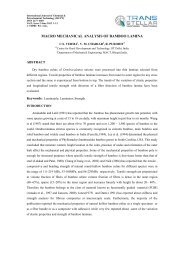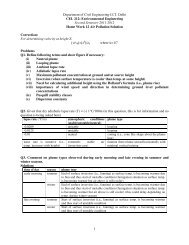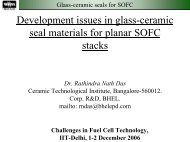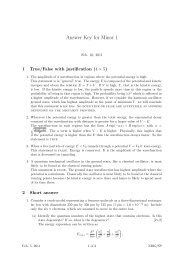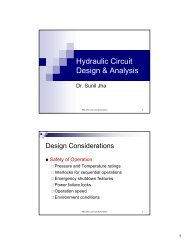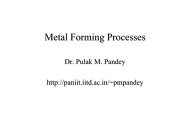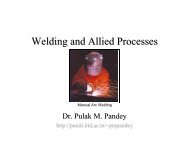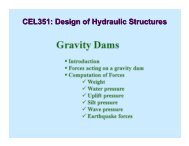Automotive spark-ignited direct-injection gasoline engines
Automotive spark-ignited direct-injection gasoline engines
Automotive spark-ignited direct-injection gasoline engines
You also want an ePaper? Increase the reach of your titles
YUMPU automatically turns print PDFs into web optimized ePapers that Google loves.
530<br />
F. Zhao et al. / Progress in Energy and Combustion Science 25 (1999) 437–562<br />
diameters of less than 10 mm. The new EPA “fine particle”,<br />
or PM2.5, standard includes all particles having equivalent<br />
diameters of less than 2.5 mm. This indicates the heightened<br />
interest in smaller particles that is reflected in the evolution<br />
of PM emissions standards. For particulates from diesel<br />
<strong>engines</strong>, only particles in the size range above 100 nm in<br />
diameter were found to have any significant effect on the<br />
mass-weighted PM10 and PM2.5 mean values, and nuclei<br />
mode particles were found to have little or no effect on<br />
the mass-weighted distribution regardless of the number<br />
density [233].<br />
Historically, <strong>gasoline</strong> <strong>engines</strong> have been exempt from the<br />
requirement to meet the particulate emissions standard for<br />
diesel <strong>engines</strong>. The justification for this has been that <strong>gasoline</strong><br />
<strong>engines</strong> produced particulate emissions that were on the<br />
order of only 1% of those diesel <strong>engines</strong>. This was certainly<br />
the case prior to the advent of recent diesel particulate legislation<br />
[235]. Recent studies indicate that current <strong>gasoline</strong> SI<br />
<strong>engines</strong> often emit an increased fraction of nanoparticles<br />
even though steady-state particulate number emissions are<br />
generally several orders of magnitude lower than those from<br />
modern diesel <strong>engines</strong> [234,236]. Particulate number<br />
emissions from <strong>gasoline</strong> <strong>engines</strong> have also been shown to<br />
increase significantly when operated under high-load, transient<br />
and cold-start conditions. It was reported by Graskow<br />
et al. [236] that, unlike the PM emissions from diesel<br />
<strong>engines</strong>, the particulate emissions from PFI <strong>engines</strong> are<br />
quite unstable. Typically a stable baseline concentration of<br />
engine-out PM emissions is on the order of × 10 5 particles/<br />
cm 3 ; however, a “spike” in the PM emissions is occasionally<br />
observed. These spikes are found to be composed of nearly<br />
100% volatile particles of less than 30 nm in diameter, and<br />
can exhibit number densities exceeding 100 times that of the<br />
baseline concentration. An analysis of particulates from PFI<br />
<strong>engines</strong> by Andrews et al. [235] revealed that the bulk of the<br />
mass is ash, with the second largest fraction being unburned<br />
lubricating oil. Carbon emissions were found to be significant<br />
only at high load with mixture enrichment, whereas, at<br />
other operating conditions, carbon was reported to comprise<br />
less than 10% of the total PM mass. The large ash fraction of<br />
the <strong>gasoline</strong> PM emissions were found to include a large<br />
fraction of metal compounds, with calcium and sodium<br />
evident for operation at low load without EGR, and copper<br />
and magnesium predominant for operation with EGR.<br />
Preliminary research indicate that GDI <strong>engines</strong>, as evolving<br />
powerplants for automotive applications, may emit a<br />
larger amount of particulates than do conventional PFI<br />
<strong>engines</strong>, especially during stratified-charge operation.<br />
Depending on the degree of combustion system optimization,<br />
smoke emissions from prototype GDI <strong>engines</strong> could be<br />
as high as 1.2 BSU [100,101,210]. A comparison of the<br />
particulate emissions for a current PFI SI engine, a current<br />
production GDI engine and a 1995 European IDI diesel<br />
engine for the US FTP cycle is illustrated in Fig. 94(a)<br />
These data represent mass measurements of particulate<br />
matter collected on filter media. It may be seen that the<br />
level of PM emissions for the GDI engine is between<br />
those of the diesel and PFI SI <strong>engines</strong>. As reported by<br />
Maricq et al. [237], the PM emissions from a vehicle<br />
powered by a GDI engine are on the order of 10 mg/mile.<br />
In comparison, the PM emissions from a comparable dieselpowered<br />
vehicle are on the order of 100 mg/mile. As<br />
compared to the 1–3 mg/mile PM emissions from a model<br />
PFI engine [235,237], the PM emissions from current<br />
production GDI <strong>engines</strong> are relatively high, even though<br />
they are well below the current US standard of 80 mg/<br />
mile as measured on the FTP test cycle. In interpreting<br />
this published comparison, it should be noted that both the<br />
PFI and GDI <strong>engines</strong> have been developed and massproduced<br />
without major specific efforts being <strong>direct</strong>ed<br />
towards the minimization of particulate emissions.<br />
Graskow et al. [238] measured the particulate emissions<br />
from a 1998 Mitsubishi GDI engine using a chassis-dynamometer<br />
test. It was reported that the average polydisperse<br />
number concentration was on the order of × 10 8 particles/<br />
cm 3 and that the number-weighted, geometric mean particle<br />
diameter was from 68 to 88 nm. In contrast, modern PFI<br />
<strong>engines</strong> tested by the same authors [234,236] emit average<br />
particulate number concentrations ranging from 10 5 particles/cm<br />
3 at light load to 10 7 particles/cm 3 at high load.<br />
Older PFI <strong>engines</strong> have been shown to emit number concentrations<br />
in excess of 10 8 particles/cm 3 for conditions corresponding<br />
to highway cruise operations. It was also reported<br />
that, for the operating conditions tested, the numberweighted,<br />
geometric mean diameters of the particulate<br />
matter emitted from the GDI engine are larger as compared<br />
to the PFI <strong>engines</strong> tested. This relatively large mean particle<br />
size is likely to increase the particulate mass emissions from<br />
the GDI engine, but could also lead to a decrease in the<br />
relative fraction of particles emitted in the nanoparticle<br />
size range.<br />
Maricq et al. [237] investigated the PM emissions from a<br />
1.83L, four-cylinder, four-valve production GDI engine for<br />
a range of operating conditions. As illustrated in Fig. 94(b),<br />
the particle number emissions are found to increase by a<br />
factor of 10–40 when the operating mode of the GDI engine<br />
is stratified-charge instead of homogenous-charge. The<br />
emissions of particulate matter exhibit a strong dependence<br />
on the GDI <strong>injection</strong> timing, and it was observed that the<br />
particle number and volume concentrations increase markedly<br />
as the <strong>injection</strong> timing is retarded. Advancing the <strong>spark</strong><br />
timing generally yields an increase in both the particle<br />
number concentration and the mean particle size for both<br />
homogeneous and stratified-charge operation. An increase<br />
in the engine speed and load generally leads to an increase in<br />
PM emissions; however, this trend is dependent on the <strong>injection</strong><br />
timing for stratified-charge operation. Based upon a<br />
chassis-dynamometer test that emulated the FTP test<br />
cycle, it was found that the PM emissions exhibit very<br />
substantial fluctuations, with a strong correlation existing<br />
between vehicle acceleration and the observed increases in<br />
PM emissions. These increases are theorized to occur



